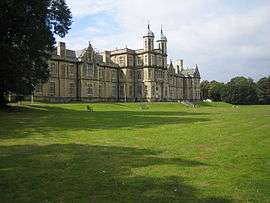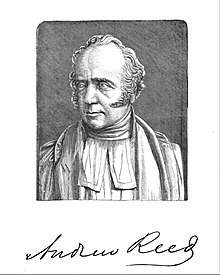Snaresbrook Crown Court
Snaresbrook Crown Court is a historic, Grade II listed building situated in Snaresbrook, an area within the London Borough of Redbridge. It is one of 12 Crown Courts serving Greater London and is designated as a third-tier court. It is set within 18 acres of grounds and has its own lake, known as Eagle Pond. It operates 20 court rooms and manages 7,000 cases a year, making it the busiest Crown Court in the United Kingdom.

Construction of the building began in 1841 and finished two years later. It was built to a design by the English architects George Gilbert Scott and William Bonython Moffatt, who at that time we're prolific designers of workhouses and hospitals and churches. Snaresbrook Crown Court was originally built as an orphanage at the behest of the philanthropist Andrew Reed who named it the Infant Orphanage Asylum; later it became the Royal National Children's Foundation. Under various titles, it remained an orphanage until 1938 when it became the Royal Wanstead School. The building continued as a school until 1971,[1] although plans were in place by the mid-1960s for it to become a court.[2]
The building opened as a Crown Court on 26 November 1974. It has undergone extensions and alterations since, with the last being an outer annex, not connected to the original building, which was built to a cost of £3 million in 1988. The court is located on Hollybush Hill, and is opposite the junction to High Street, Wanstead. The nearest tube station is Snaresbrook on the Central line.[3]
History
Orphanage

The Wanstead Infant Orphan Asylum was founded by the philanthropist Andrew Reed in 1827 and was based in Hackney. In the 1830s, and owing to a lack of space in the current building, Reed applied to the Crown Estate for a section of land in Snaresbrook, which was then part of Wanstead Forest, and a grant to help fund the building of a new premises. The application was successful and construction started on 27 June 1841. Between 1835 and 1844 George Gilbert Scott and William Bonython Moffatt were in partnership and were prolific designers of workhouses and hospitals and churches.[4] They were chosen to design the orphanage; the foundation stone was laid by Albert, Prince Consort in 1841.[5]
The Infant Orphanage Asylum was officially opened on 27 June 1843 by Leopold I of Belgium.[2] It is designed in the Elizabethan style and cost £35,000 to construct.[5] The 1881 census recorded there being 74 staff and over 400 children at the institution.[6] King George V, who was the patron of Reed's charity, renamed the asylum the Royal Infant Orphanage in 1919.[5] The charity’s eligibility criteria required that children had to be either fatherless or entirely orphaned;[7] under the age of seven;[8] and that their late fathers would have to have been considered by the trustees to be either "creditable" (not earning less than £50 a year upon their death), "respectable" (£100 a year), or "very respectable" (£400 a year).[2] In exceptional circumstances, the institution accepted children whose fathers were still alive but "subject to confirmed lunacy or paralysis", according to a reporter for the Derbyshire Courier. Once admitted the institution would house and look after the children up to the age of 15. The youngest recorded child to reside at the orphanage was a six-month-old girl in 1849.[9]
School
In 1938 the building became the Royal Wanstead School and Prince George, Duke of Kent became its patron.[10] As well as a refuge for orphans, it was also allowing children from impoverished families to join its register. These inductions were brief and stopped altogether in 1942 owing to the introduction of the welfare state, which allowed poor families to live together.[2] The school received grammar school status in the years after the establishment of the Education Act in 1944 and was funded by the Local Education Authority. By the late 1960s the school was experiencing a decline in pupil admissions which resulted in financial difficulties. It eventually closed in 1971.[5] The children's charity exists today under the name of the Royal National Children's Foundation.[11] On Christmas Day of that year the building came into the ownership of the Department of the Environment who began a £1.6m refurbishment project, creating what is evident today. The building's chapel and North Wing are the only two areas to remain in their original states.[2]
Crown Court
.jpg)
With the school winding down by the mid 1960s, work began on converting certain sections of the building into a court. It opened, as such, on 1 April 1965 when the first case was heard. The building had one judge and a group of 12 staff who managed 325 cases within the first year.[2] The building received Grade II listed status on 11 November 1968.[12]
Snaresbrook Crown Court was officially opened on 26 November 1974 by Lord Widgery, who was, at that time, Lord Chief Justice. Further improvements were made to the site between 1976 and 1979, but in November 1981 a fire destroyed three courtrooms and damaged two others. Renovations were made, and by 1988, five more court rooms, including a separate annex, built to a cost of £3m, had been added, bringing the total to 20. The court manages around 7,000 cases a year, making it the busiest Crown Court in the United Kingdom.[2]
See also
- Courts of the United Kingdom
- List of Crown Court venues in England and Wales
References
- "Places of Historical Interest in Redbridge", London Borough of Redbridge. Retrieved 5 August 2015.
- "A History: Snaresbrook Crown Court", Information leaflet produced by HM Courts & Tribunals Service, p. 2.
- "Snaresbrook Crown Court", Court Tribunal Finder. Retrieved 5 August 2015.
- Historic England, "Former Church of the Holy Trinity (1210076)", National Heritage List for England, retrieved 26 June 2019
- "Wanstead Infant Orphan Asylum, Wanstead, London", Children's Homes website. Retrieved 5 August 2015.
- "1881 Census: Infant Orphan Asylum, Wanstead, Essex", Children's Homes website. Retrieved 5 August 2015.
- "Infant Orphan Asylum, Wanstead", Aris's Birmingham Gazette, 28 March 1863, p. 4.
- "Wanstead: Introduction" A History of the County of Essex: Volume 6, ed. W R Powell (London, 1973), pp. 317–322. Retrieved 7 August 2015.
- "Infant Orphan Asylum, Wanstead", Derbyshire Courier, 10 November 1849, p. 2.
- "Mainly Personal", Western Daily Press, 15 March 1939, p. 6.
- "A Brief History: Royal National Children's Foundation" Archived 2015-09-24 at the Wayback Machine, Royal National Children's Foundation. Retrieved 5 August 2015.
- Historic England. "Crown Court (Grade II) (1358004)". National Heritage List for England. Retrieved 26 June 2019.